Join More Than 50,000+ Subscribers and get latest camera news and rumors
NEW CAMERA VIDEOS ON YOUTUBE
Download Our Android App
|
By admin, on December 22nd, 2010
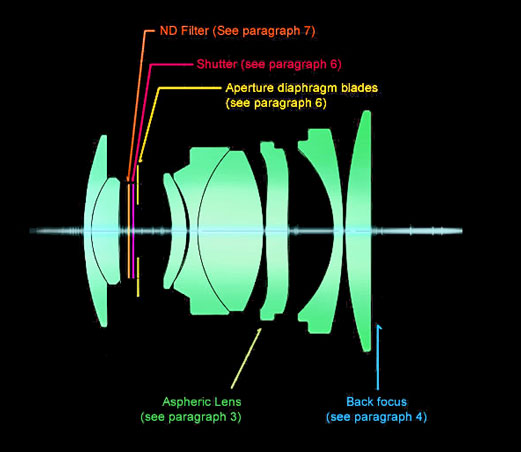
The dual challenge of achieving high performance within a compact body. The solution: Fixed-type lens.
The X100 was originally conceived as a slim and compact camera for users to take with them wherever they go. When we first began considering the lens design, we examined the many possibilities from a variety of perspectives, for example, the aperture value and lens size in the case of a zoom lens and lens-body combinations in the case of an interchangeable lens system. As a result, we determined that a non-collapsible, single focal length lens was the ideal choice to meet our two goals of achieving the product concept and delivering the high level of quality demanded by professional users.
Regarding the focal length, we considered the 135 equivalent of 24mm, 28mm, 35mm and 50mm. For each length, we evaluated the relationship between the F value and lens size, capability to satisfy user expectations, and the breadth of their application. We selected the 35mm lens as the best match for the camera concept.
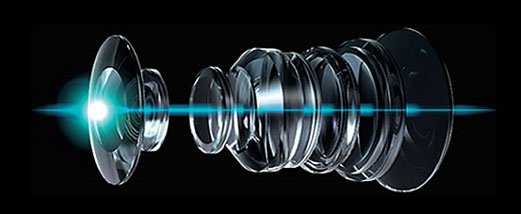
Road to the F2 aperture value.
Designing an F1.6 or F1.8 lens is not so difficult; however, in the case of a digital camera, even if an aperture larger than F2 is used, the light receiving elements on the sensor cannot effectively use the brighter portion of the incoming light because of low incident light gathering efficiency.
Also by choosing an aperture of F2, it is possible to achieve a higher MTF* level when the aperture is closed to F4, F5.6, F8, etc. In most photographic situations, we envisage that users will often use an aperture that is 1 to 2 stops higher than F2. Therefore, in designing the lens, we put a priority on capturing superior quality photos with exceptional expression of detail in the aperture range of F4 to F5.6.
*MTF: Modulation Transfer Function is an index of the image formation performance of the lens. The value indicates the ability to reproduce contrast over a range of spatial frequencies.
Click here to Read More
By admin, on December 10th, 2010
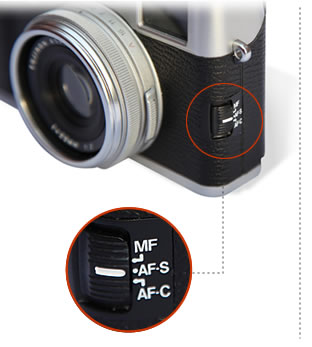
Focusing details revealed
The X100 offers three focusing options (the camera is still in development and, therefore subject to change), selected by a switch on the left hand side of the body.
With manual focus selected, focusing is achieved using the focus ring around the lens barrel. A distance indication bar enables you to pre-focus if required, or you can simply use the electronic viewfinder to focus accurately. There is, however, no rangefinder focusing capability.
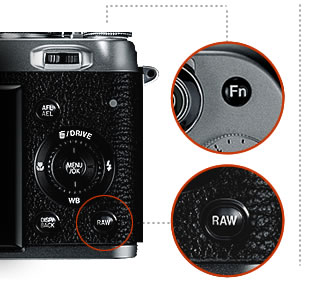 RAW functionality explained RAW functionality explained
The RAW button over the camera body is a special feature which adds an extra excitement while shooting, the RAW button has two key functions, when shooting in JPEG mode, it enables the user to instantly capture both RAW and JPEG files, plus it also allows RAW files to be developed in camera.
Quick access to ISO settings, Fn button on the X100’s top-plate gives instant access to ISO settings as a default.
Image credit – [ FujifilmUK ]
Support New Camera Buy Music CD or Digital Camera at amazon it helps this site, and you do not pay anything extra, it is just a way to help support this site.

By admin, on September 21st, 2010
FUJIFILM FinePix X100 is a APS – C Sensor Camera with a fixed prime F2 lens, the expected price is around $1500 with is a bit high and which may keep this product away from regular dslr or high end compact users.
*Design and specifications may be subject to change without notice.
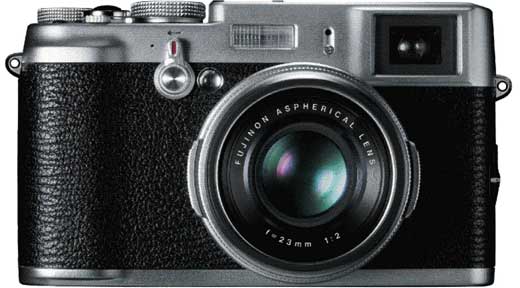 Fujifilm FinePix X100 - High Res 6.8MB - Click on the Image to Download 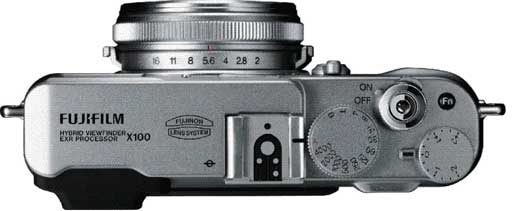 Fujifilm FinePix X100 - High Res 4MB - Click on the Image to Download 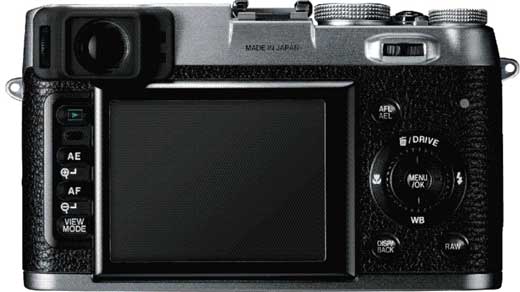 Fujifilm FinePix X100 - High Res 4.7MB - Click on the Image to Download Technical Specifictions
| Please note that specifications highlighted in blue are subject to change. |
|
Model Name |
FinePix X100 |
|
|
Number of effective pixels |
12.3 million pixels |
|
|
CCD sensor |
APS-C CMOS Sensor |
|
|
Storage media |
SD / SDHC / SDXC memory card |
|
|
Lens |
Name:
High-performance Fujinon lens with Super EBC Coating
Focal length:
23mm, equivalent to 35mm equivalent to 35mm camera
Aperture range:
F2 to F16 |
|
|
PPT: Sensitivity |
From ISO 200 to 6400. In expanded mode, ISO 100 and 12800 are settable. |
|
|
PPT: Exposure control |
49-point metering and variable AF target size |
|
|
Exposure mode |
Programmed auto mode, Aperture priority mode, Shutter priority mode, and Manual mode. |
|
|
Exposure compensation |
-2.0EV-+2.0EV |
|
|
Shutter speed |
Bulb, 30 sec. to 1/4000sec. |
|
|
PPT: Continuous shooting |
High-speed 5fps burst shooting |
|
|
Focus |
High-speed contrast AF |
|
|
Q&A: White balance |
White balance setting in Kelvin values |
|
|
Optical Viewfinder |
0.5x magnification with approx. 90% frame coverage |
|
|
Electronic Viewfinder |
Ultrafine 1,440,000-dot LCD |
|
|
LCD monitor |
2.8-inch, Colour LCD monitor, Approx. 460,000dots |
|
|
Movie recording |
1280×720 HD with stereo sound |
|
|
PPT: Other functions |
Electronic level, Depth of Field preview capability (EOF) , Selection of 3 “mechanical” shutter sounds, Film simulation modes |
|
|
Dimensions |
126.5(W) x 74.4(H) x 53.9(D) mm including lens |
|
Read more: FUJIFILM FinePix X100 With 12.3 Megapixel APS-C CMOS Sensor
By admin, on October 12th, 2014
 The Fujifilm X30 is a clone of X20 camera, since it features same small sensor and image processor as of X20 camera, on the other side we have Sony RX100 M3 camera that features 1 inch large sensor and very small and compact body design… take a look at the core specification below…. The Fujifilm X30 is a clone of X20 camera, since it features same small sensor and image processor as of X20 camera, on the other side we have Sony RX100 M3 camera that features 1 inch large sensor and very small and compact body design… take a look at the core specification below….
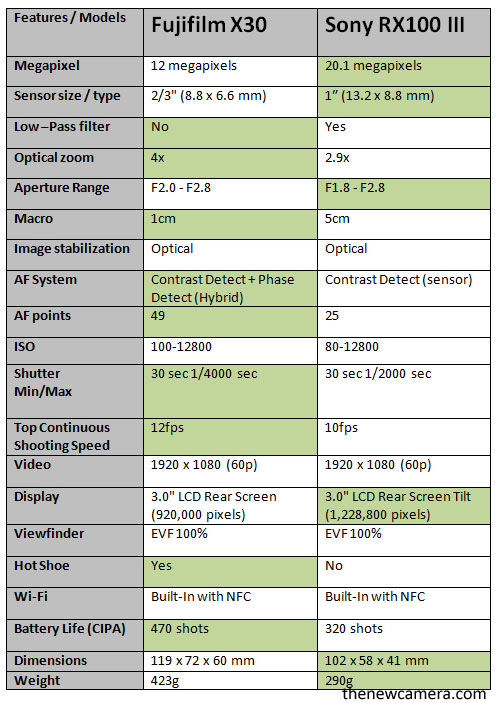 Sensor Tech: The fujifilm features 2/3″ CMOS image sensor and built with X-Trans bespoke pixel array, the pixel pattern literally reduce the need of optical low pass filter above the sensor, the other major advantage of the X-Trans sensor is the presence of active phase AF pixels inside the sensor, so you get HYBRID AF system that uses contrast and phase AF method with the X30 camera to acquire AF. Sensor Tech: The fujifilm features 2/3″ CMOS image sensor and built with X-Trans bespoke pixel array, the pixel pattern literally reduce the need of optical low pass filter above the sensor, the other major advantage of the X-Trans sensor is the presence of active phase AF pixels inside the sensor, so you get HYBRID AF system that uses contrast and phase AF method with the X30 camera to acquire AF.
the Sony RX100 M3 comes with large 20.1 megapixel 1″ Exmor R CMOS sensor features backside-illuminated technology, due to the large sensor size and bright optical lens the sensor get more light compared to Fuji X30 sensor and the difference is clearly visible… the RX100 M3 does produces excellent level of details in the images by maintaining the minimum amount of noise.
Lens: As we have already said that the lens used in the RX100 M3 camera delivers more light compared to the X30 camera not only due to the difference in the aperture range but also due to the difference in the size of lens elements, the RX100 M3 lens elements are designed for large sensor by and they also feature low aperture range… so the RX100M3 will provide more shallow DOF and noise less low-light images when compared to the X30.
Being small the Fuji lens is able to focus as close as 1cm, the Sony RX100 M3 macro range is limited to 5 cm, you also get 1X more optical zoom lens with Fuji X30.
AF System: We have no doubt that the Fuji X30 will do faster AF since it features advance AF sensor that utilizes Phase and Contrast based methods, on the other side we have Sony RX100 M3 uses traditional contrast detect AF system.
Top continuous speed: Fujifilm x30 can take up to 12 continuous shots whereas Sony RX100 III can take up to 10 shots continuously.
Display: Both the cameras support the same 3” tilting LCD but their pixels varies. Sony RX100 III has a pixel density of 1,228,800 pixels whereas Fujifilm x30 has a pixel density of 920000 pixels.
Hot Shoe: Fujifilm x30 has a hot shoe on its body to attach an external flash for better lightning conditions when required.
Battery life: Fujifilm X30 can take 470 shots in one cycle but Sony RX100 III can take 320 shots only.
Dimensions: Sony RX100 III is smaller than Fujifilm X30.
Weight: Sony RX100 III is lighter than Fujifilm X30.
Verdict: We highly recommend you to buy the Sony RX100 M3 camera.
Buy Fuji X30 from – Amazon and B&H || Buy Pre-order RX100 M3 at Amazon | B&H
By admin, on February 28th, 2013
High ISO image comparison published by japanese website dslr-check.at.webry, take a look at the comparison below
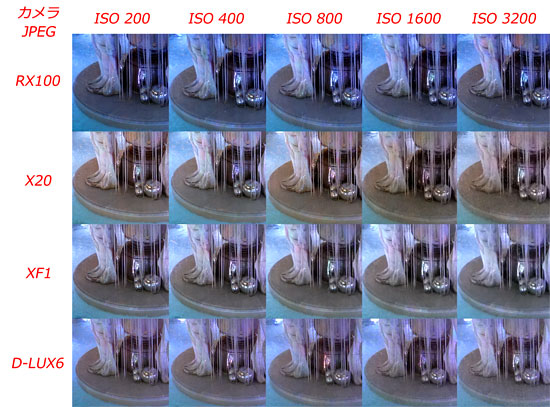 Click here to see en-large Image Click here to see en-large Image
via-dslr-check.at.webry.info
By admin, on May 16th, 2012
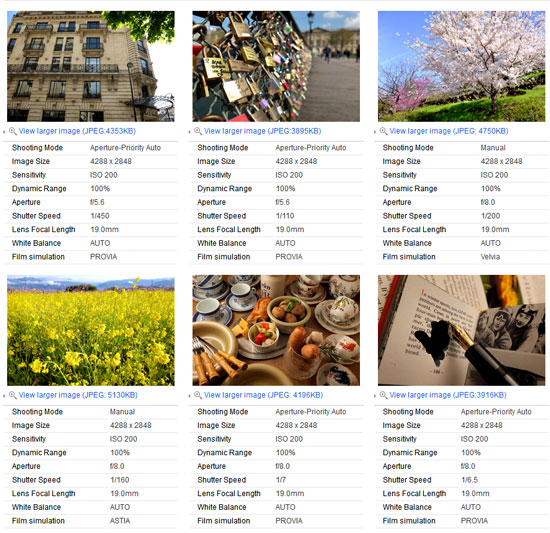
Fujifilm announced its wide angle lens WCL-X100 fro X100 on May 10th, Now Fujifilm WCL-X100 Sample Images available at Fujifilm USA website,
See Sample Images at Fuji Website
See more about Fujifilm WCL-X100 Lens
By admin, on January 25th, 2012
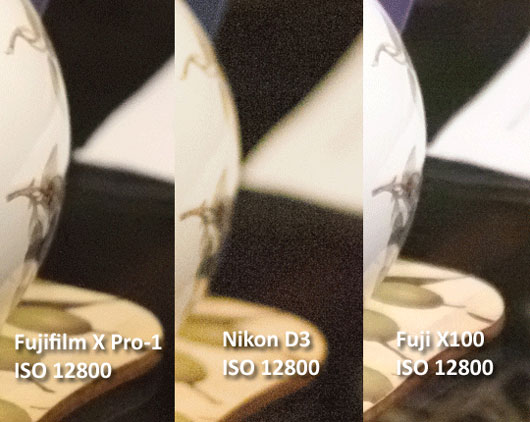
A Romanian website (www.f64.ro) compared Nikon D3 and Fuji X100 with new Fujifilm X Pro-1, we know that D3 sensor is and image processor is now approx 4 years, 5 months, and 2 days old (211 days left for D3 next birthday) , I’d love to see a side-by-side comparison with the recently announced Nikon D4. However the images of X Pro-1 have less noise than the Nikon D3 and Fuji X100.
Conclusions (Translated by google)
As seen, X-Pro 1 is doing very well at high ISO, better than the X100 or D3 and taking into account the pixel density is higher (16MP vs. 12MP) means that evolution is even more impressive than you can see in these frames. Let’s not forget the Nikon D3 camera was revolutionary in terms of ISO so X-Pro has only one reason for praise.
Images taken for all these tests can be downloaded from here (23.2MB)
Buy Fuji X Pro-1 from Amazon
Buy Fujifilm X100 from Amazon
Buy Nikon D3 at Amazon
news src – fotoactualidad.com
|
KEEP THIS BLOG ALIVE - Support New Camera Buy Canon Lenses, Buy Music CD or Digital Camera at amazon it helps this site, and you do not pay anything extra, it is just a way to help support this site.

|




















